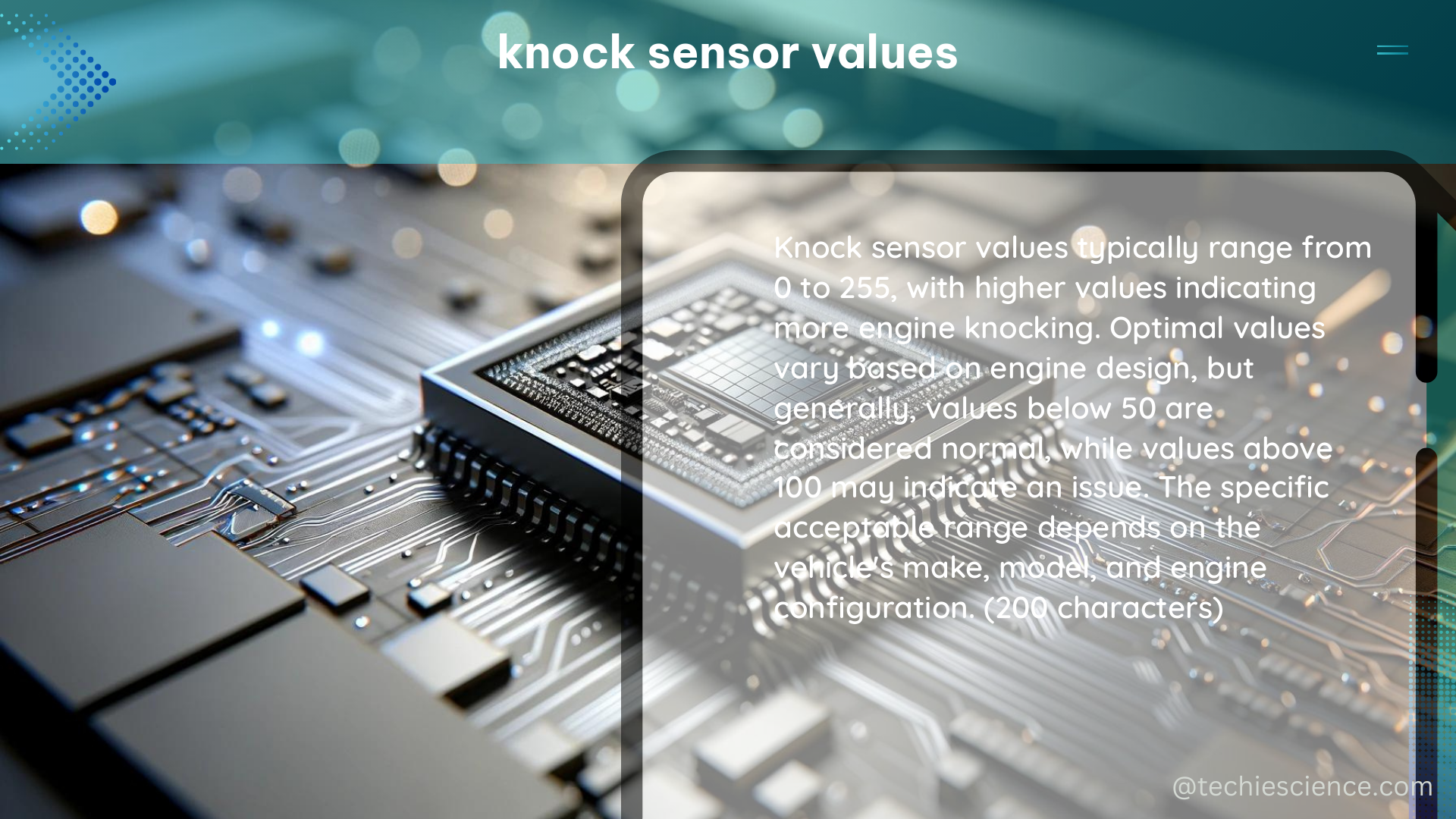Knock sensor values are crucial in detecting engine knocking, a condition that can lead to engine damage if left unchecked. These sensors generate voltage spikes when they detect engine knocking, and the voltage can be measured to determine the severity of the knocking. Understanding and properly interpreting knock sensor values is essential for maintaining engine health and performance.
Understanding Knock Sensor Signals
Knock sensors are designed to detect the high-frequency vibrations associated with engine knocking. When knocking occurs, the sensor generates voltage spikes that can reach up to several hundred volts. However, these spikes are typically very short, lasting less than a millisecond.
To accurately measure knock sensor values, it’s important to use a circuit that can capture these short, high-voltage spikes and convert them into a signal that can be read by a microcontroller or other device. One common approach is to use a circuit with diodes and a capacitor to protect the microcontroller inputs and filter the signal.
Another method is to use an opto-isolator, which can simplify the circuit design and make it easier to read the knock sensor values. The opto-isolator helps to protect the microcontroller from the high-voltage spikes generated by the knock sensor.
Interpreting Knock Sensor Values

When measuring knock sensor values, it’s important to focus on the changes in the voltage spikes rather than the absolute values. The presence of engine knocking is indicated by a change in the voltage spikes generated by the knock sensor, not the specific value of the spikes.
To illustrate this, let’s consider a hypothetical scenario:
| Engine Condition | Knock Sensor Voltage Spikes |
|---|---|
| Normal operation | 50-100 mV |
| Mild knocking | 100-200 mV |
| Severe knocking | 200-500 mV |
In this example, the absolute values of the knock sensor voltage spikes are less important than the change in the values. If the sensor is reading 50-100 mV during normal operation and the values suddenly increase to 200-500 mV, it indicates the presence of severe engine knocking, which requires immediate attention.
Factors Affecting Knock Sensor Values
Several factors can influence the values measured by a knock sensor, including:
- Engine Load: Higher engine loads can increase the likelihood of knocking, leading to higher voltage spikes from the knock sensor.
- Fuel Octane: Using a lower-octane fuel can increase the risk of engine knocking, resulting in higher knock sensor values.
- Ignition Timing: Retarded ignition timing can also contribute to engine knocking and higher knock sensor readings.
- Sensor Condition: A worn or damaged knock sensor may not accurately detect knocking, leading to inconsistent or unreliable values.
It’s important to consider these factors when interpreting knock sensor values and troubleshooting any issues related to engine knocking.
Knock Sensor Diagnostics
Monitoring and analyzing knock sensor values can provide valuable insights into the overall health and performance of an engine. By tracking changes in knock sensor values over time, you can identify potential issues and take proactive steps to address them.
Some common diagnostic techniques for knock sensors include:
- Voltage Spike Analysis: Examining the voltage spikes generated by the knock sensor can help identify the severity and frequency of engine knocking.
- Frequency Analysis: Analyzing the frequency of the voltage spikes can provide information about the specific type of knocking occurring in the engine.
- Comparative Analysis: Comparing knock sensor values across multiple cylinders or over time can help pinpoint the source of any knocking issues.
By leveraging these diagnostic techniques, you can gain a deeper understanding of your engine’s knock sensor performance and take appropriate actions to maintain optimal engine health and efficiency.
Conclusion
Knock sensor values are a critical parameter in engine management systems, providing valuable insights into the presence and severity of engine knocking. By understanding the principles of knock sensor operation, interpreting the measured values, and utilizing diagnostic techniques, you can effectively monitor and maintain the health of your engine.
Remember, the key to working with knock sensor values is to focus on the changes in the voltage spikes rather than the absolute values. By staying vigilant and taking proactive measures, you can ensure your engine runs smoothly and avoid costly repairs down the line.
Reference:
- Increasing knock detection sensitivity by combining knock sensor signal with cylinder pressure signal, ScienceDirect, https://www.sciencedirect.com/science/article/abs/pii/S0888327021009894
- Knock sensor read – Project Guidance, Arduino Forum, https://forum.arduino.cc/t/knock-sensor-read/508341
- Knock Sensor Values, Chevy Impala SS Forum, https://www.impalassforum.com/threads/knock-sensor-values.1322302/
- Quantitative Performance Evaluation of a Knock Sensor for Vibration-Based Fault Diagnosis in a Planetary Gearbox, Sungkyunkwan University, https://shrm.snu.ac.kr/upload/staff/2469303126_7a1d53a1_Quantitative%2BPerformance%2BEvaluation%2Bof%2Ba%2BKnock%2BSensor%2Bfor%2BVibration-Based%2BFault%2BDiagnosis%2Bin%2Ba%2BPlanetary%2BGearbox.pdf
- Datalog – Knock Sensor, Mustang Evolution Forum, https://www.mustangevolution.com/threads/datalog-knock-sensor.353393/

The lambdageeks.com Core SME Team is a group of experienced subject matter experts from diverse scientific and technical fields including Physics, Chemistry, Technology,Electronics & Electrical Engineering, Automotive, Mechanical Engineering. Our team collaborates to create high-quality, well-researched articles on a wide range of science and technology topics for the lambdageeks.com website.
All Our Senior SME are having more than 7 Years of experience in the respective fields . They are either Working Industry Professionals or assocaited With different Universities. Refer Our Authors Page to get to know About our Core SMEs.